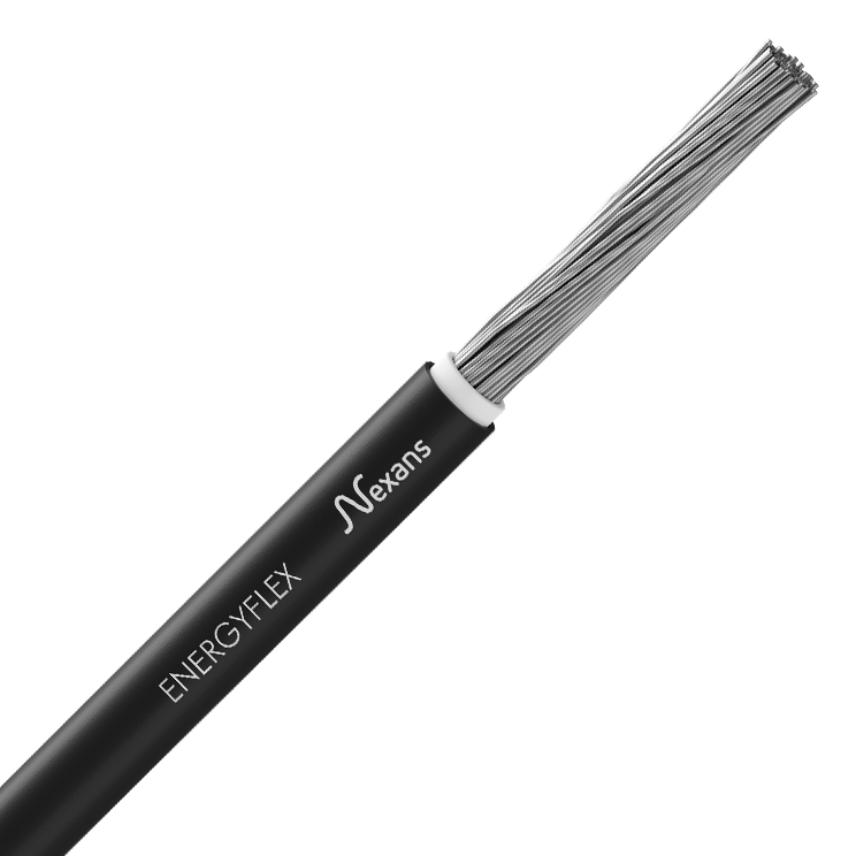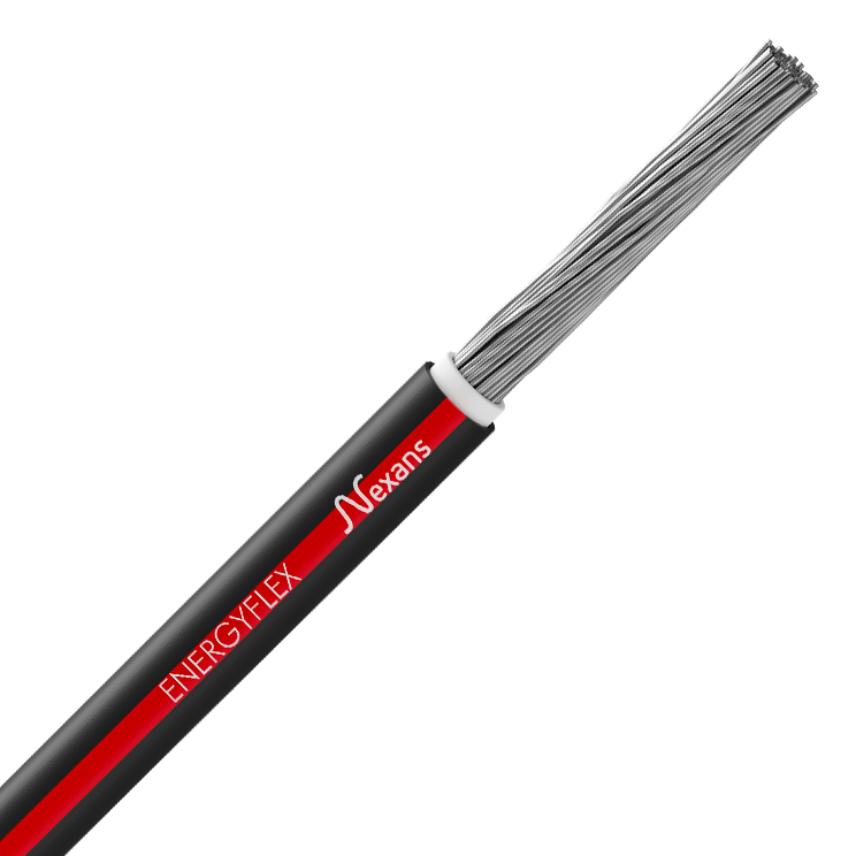- Produkter
- Segment
- Nyheder
- Services og support
- Vi er Nexans
- Bæredygtighed
- Søg
- Kontakt os
- Sammenlign
- Logon
ENERGYFLEX® 1x4mm² D500


ENERGYFLEX® 1x4mm² D500
ENERGYFLEX
Energyflex® cables are designed to comply with the international standards of the solar plants.
They are dedicated to the photovoltaic system direct current (D.C.) side with a nominal D.C. voltage of 1.5 kV and a maximum D.C. voltage of 1.8 kV. These cables are suitable for permanent outdoor long-term use, under variable and harsh climate conditions.
They are designed and tested to operate at a normal maximum conductor temperature of 90°C and for 20,000 hours up to 120°C. Therefore, the expected period use is 30 to 40 years under normal usage conditions (lifetime acc. to Arrhenius-Diagram).
- Varenr. : 20056098-901-05
- E-nummer : 3427640020811
- EAN : 3427640020811
Beskrivelse
Beskrivelse
Standarder
-
InternationalEN 50618; IEC 62930
-
National13782-99HH
Anvendelse
ENERGYFLEX®-kabel bruges til solcelleanlæg. Dette kabel forbinder fotovoltaiske paneler og paneler til omformere. Den bruges til fast installation udendørs eller indendørs.
Konstruktion
1. Leder: Fleksibel tinnet kobber klasse 5 i henhold til IEC 60228.
2. Isolering: Halogenfri polyolefin
3. Yderskade: Halogenfri polyolefin - Farve sort * * Blå eller Rød stribe på forespørgsel - Andre farver på forespørgsel
Maerkning
ENERGYFLEX® PV1-F PV1000-F 1x s mm² 0.6/1kV Nexans 269 Photovoltaic
Current rating temperature
Ambient temperature = 60°C
Maximum conductor temperature = 120°C
TECHNICAL INFORMATION (1/3)
|
Peroxide Crosslinked Material |
Halogen Free Material |
|
Cable insulation and jacket are both based on crosslinked polymers. Crosslinking is performed using peroxide technology. It means that the polymer macromolecular chains are physically bound by chemical links. The peroxide crosslinking is one of the most efficient ways to crosslink because it allows a crosslinking on a melt polymer, leading to a homogeneous network and a high density of links among the material thickness.
Advantages
Fig: The peroxide molecule decomposition leads to the formation of chemical bonds between polymer chains. After crosslinking, a three-dimensional network is obtained. The polymer chains are no more capable to slip among themselves and an infusible material is obtained with improved properties. |
Halogen based materials are widely used in cable industry with PVC and flame retardant additives. Halogens are a specific family of chemical elements: Fluorine (F), Chlorine (Cl), Bromine (Br), Iodine (I), Astatine (At). These elements are well-known to bring high performances regarding fire retardancy. However, they generate during the burning phase a heavy dark smoke with the formation of highly toxic and corrosive gases. Our Energyflex® cables are totally free of these elements.
Halogen content by Ion Chromatography Fig: A piece of material is burned in a tube and the emitted gases are carried and trapped for analysis. For a precise dosage of these different halogen elements, ion chromatography allows to separate these elements and to quantify accurately the amount of each species.
Corrosivity of smoke Fig: As seen before, a piece of material is burned and the gases are trapped in a liquid solution to measure the corrosivity of smoke. The pH and conductivity are measured and should be higher than respectively 4.3 and 10 µS/mm. |
TECHNICAL INFORMATION (2/3)
|
Long Term Thermal Endurance |
Sunlight Resistance |
|
The cable ageing under thermal oxidation leads to the degradation of the polymer material. To predict or at least to estimate what could be the lifetime of a material under thermal ageing, one uses the Arrhenius procedure depicted in the IEC 60216-1 to 4. The main principle is to age the material at high temperatures and then, using the Arrhenius law, to estimate/predict the lifetime at operating temperature (120 or 90°C).
Arrhenius plot Ageing was performed at 4 different temperatures: 135°C, 150°C, 165°C and 180°C. The line (linear plot) allows to predict the lifetime at 120 and 90°C. The red dots represent the main targets we are looking for, i.e. the 20000h@120°C, 25years@90°C and 40years@90°C. The more the extrapolated line is above the red dots, the more the lifetime is higher than the target. The obtained extrapolation is well above the targets and thus the estimated lifetime is bigger than 40years@90°C. ##image:101760:center## Fig: Arrhenius plot of the insulation material. The criterion to determine the time to failure is chosen as a loss of 50% of the initial elongation at break. At this stage, the cable has initiated it degradation but it is not fully degraded. |
One of the main causes of material ageing regarding photovoltaic application is the exposure to UV (Ultra-Violet) light, also called photo-degradation. The cable ageing under UV light is due to the combination of the temperature and UV irradiation (harmful UV irradiation is mainly between wavelengths 300 and 400 nm on the earth surface).
Accelerated ageing Our jacketing material presents no degradation after 1 month of weathering acc. to the EN 50289-4-17 method A. ##image:101761:center## Fig: The Xenon lamp generates a spectrum close to the sunlight one. The samples are placed facing the lamp and are submitted to a specific irradiance and temperature to accelerate the UV ageing.
Beyond the standard ##image:101762:center## Fig: Here in our Nexans process, we exceed the test conditions of the EN (4000hours against 720h and 100W/m² against 43W/m² specified) and we see no change of the mechanical features. |
TECHNICAL INFORMATION (3/3)
|
Dynamic Mechanical Performances |
Fire/Flame Retardancy |
|
No dynamic mechanical tests are found in the EN 50618 standard because the cables are intended to be used without any dynamic constraints. As Energyflex® could be used for Tracker systems, we have performed additional tests:
Dynamic behaviour Dynamic/cyclic mechanical constraints lead to the conductor degradation (copper/aluminium braid degradation). In our case, the cable present very good dynamic properties and still transmit current after 100 000 cycles in both torsion and bending. ##image:101765:center## Fig: Torsion cycles: 50N ± 135° 100°/s ##image:101766:center## Fig: Reverse bending: 100N ± 45° 160°/s |
Energyflex® cables are HFFR, i.e. Halogen Free Fire Retardant cables. The material is free of halogen and is capable to withstand a flame retardant test according to the EN 60332-1-2. It means that the cable presents a good resistance regarding the flame spread with a very good self-extinguishing behavior.
Resistance to flame test The cable passes the EN 60332-1-2 where 600mm of cable are tested vertically. The flame is applied with a 45° angle and a 1kW burner. ##image:101767:center## Fig: Picture of the flame test acc. to EN 60332-1. The flame is applied 1 to 8 minutes depending on the cable diameter. The test is compliant if after the flame application, the flame extinguishes with a burned length comprises between 50 and 540mm. |
Egenskaber
Egenskaber
Konstruktion
Konstruktion
Dimensioner
Dimensioner
Elektriske egenskaber
Elektriske egenskaber
Mekaniske egenskaber
Mekaniske egenskaber
Håndteringsinformation
Håndteringsinformation
Ressourcer
Ressourcer
Dokumentation
Salgs- & leveringsoplysninger
"Want to know more about the environmental impact of the product during its life cycle ?
Please contact:: sustainable.development@nexans.com and discover the PEPecopassport® declaration available with all the details”
Ydelsesdeklaration
- Ydelsesdeklaration nr. : 1000199-FRAN
- Certificeringsdato : 17.12.2019
- AVCP (evaluering og fortløbende kontrol af resultater) : System 3
- Notificeret organ : NB 1812
- Ydelse : Dca-s2,d2,a1
Vores websider
Vælg land for at finde vores produkter og løsninger
-
Africa
- Africa
- Ghana
- Ivory Coast
- Morocco
- North West Africa
- Americas
- Asia
- Europe
- Oceania